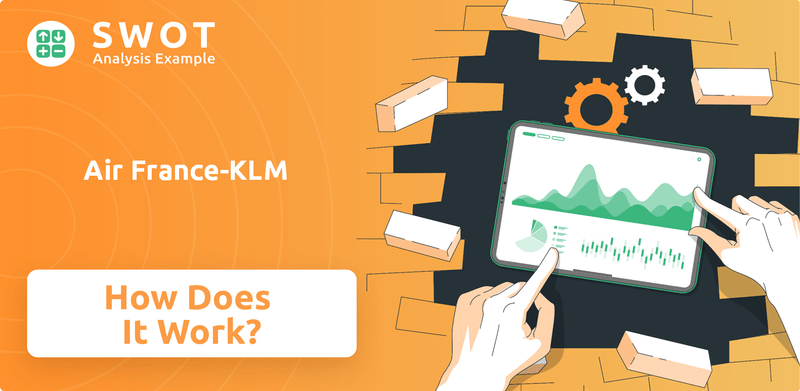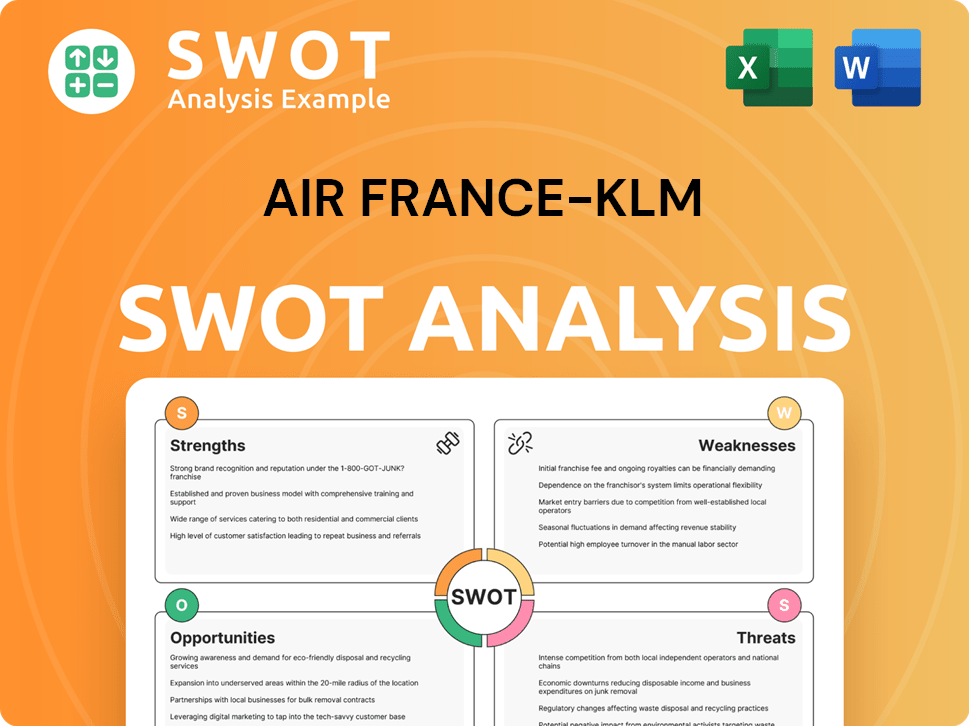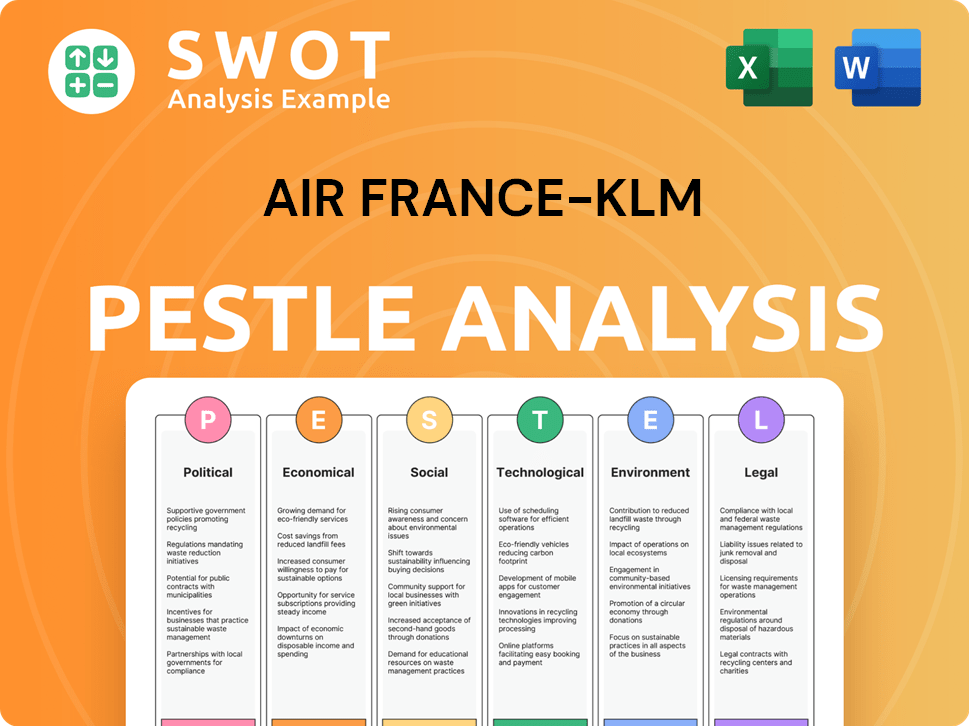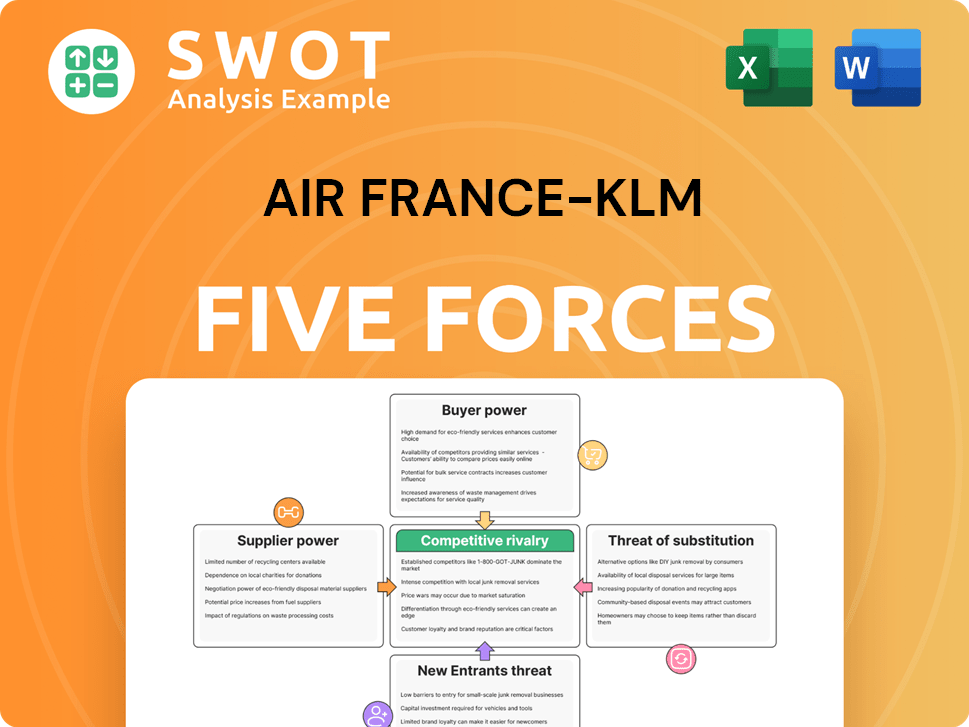Air France-KLM Bundle
How Does Air France-KLM Stay Airborne in a Competitive World?
Air France-KLM, a titan of the skies, isn't just about flying; it's a complex machine of global reach and intricate operations. Formed from the merger of Air France and KLM, this Franco-Dutch airline group has become a pivotal player in the airline industry. Understanding its inner workings is key to grasping its financial performance and strategic vision.

From managing vast Air France-KLM SWOT Analysis to navigating complex flight routes, the group’s success hinges on a multitude of factors. The airline's business model encompasses passenger flights, cargo operations, and maintenance services, all contributing to its revenue streams. This exploration will delve into the core of Air France-KLM, examining its strategies, challenges, and the forces shaping its future in the ever-evolving airline industry.
What Are the Key Operations Driving Air France-KLM’s Success?
Air France-KLM creates value through its integrated approach to air transportation, encompassing passenger services, cargo operations, and aircraft maintenance. The core offerings include scheduled passenger flights under the Air France, KLM, Transavia, and HOP! brands, serving a diverse customer base. For instance, in the first quarter of 2024, the group experienced a 6.2% increase in network capacity compared to the same period in 2023, demonstrating its operational scale and growth.
Its cargo services provide essential logistics solutions, transporting goods such as pharmaceuticals and e-commerce products. The MRO division, Air France Industries KLM Engineering & Maintenance (AFI KLM E&M), offers comprehensive maintenance, repair, and overhaul services. This division serves not only the group's fleet but also over 200 third-party airlines globally, showcasing a significant external revenue stream.
Operational processes are complex and integrated. Passenger services involve route planning, fleet management, crew scheduling, ground handling, and customer service. The company continuously invests in technology to enhance efficiency, such as digital tools for flight management. Specialized handling and logistics expertise are crucial for cargo operations, often utilizing belly capacity on passenger flights. The MRO operations involve highly skilled technicians and advanced tools to ensure aircraft airworthiness.
Air France-KLM's airline operations are multifaceted, encompassing passenger services, cargo transport, and aircraft maintenance. Effective route planning and fleet management are critical for optimizing flight schedules and minimizing operational costs. The company's focus on customer service, from online booking to in-flight experiences, is also a key aspect of its operations.
The value proposition of Air France-KLM centers on providing a comprehensive air travel experience. This includes a wide network of destinations, convenient connections, and loyalty program benefits. Strategic partnerships and a dual-hub strategy enhance the customer experience.
Several processes are crucial for Air France-KLM's success. These include route planning, fleet management, crew scheduling, and ground handling. Investments in technology and digital tools are made to improve efficiency and customer experience. Cargo operations and MRO services are also important contributors to the company's overall performance.
Customers benefit from a wide choice of destinations, convenient connections, and loyalty program advantages. The dual-hub strategy and partnerships contribute to a seamless travel experience. Air France-KLM's focus on customer service and operational efficiency enhances its value proposition.
Air France-KLM's supply chain is global, encompassing aircraft manufacturers, parts suppliers, fuel providers, and ground service partners. Strategic partnerships, such as joint ventures with Delta Air Lines and Virgin Atlantic, significantly enhance its network reach.
- Joint ventures with Delta Air Lines and Virgin Atlantic for transatlantic routes.
- Partnership with China Eastern Airlines for routes between Europe and China.
- These partnerships enable optimized flight schedules and shared code-sharing agreements.
- The dual-hub strategy with Paris-Charles de Gaulle and Amsterdam-Schiphol offers extensive connectivity.
The company's dual-hub strategy, with Paris-Charles de Gaulle and Amsterdam-Schiphol, offers extensive connectivity. This model, combined with strong brand recognition and SkyTeam membership, translates into customer benefits. For more information about the company's history, consider reading the Brief History of Air France-KLM.
Air France-KLM SWOT Analysis
- Complete SWOT Breakdown
- Fully Customizable
- Editable in Excel & Word
- Professional Formatting
- Investor-Ready Format

How Does Air France-KLM Make Money?
Air France-KLM generates revenue through a multifaceted approach, primarily focusing on passenger transportation, cargo services, and aircraft maintenance. Passenger revenue is the core driver, supported by cargo operations and the maintenance, repair, and overhaul (MRO) services provided to both the group's fleet and external clients. The company's financial health is intricately linked to its ability to optimize these diverse revenue streams.
The group's total revenues in the first quarter of 2024 increased by 5.1% to €6.7 billion. This growth was significantly influenced by the robust performance of its passenger network. The company's strategic initiatives and operational efficiencies play a critical role in its financial outcomes.
The financial performance of Air France-KLM is also influenced by its ability to navigate the complexities of the airline industry, including fluctuations in fuel prices, currency exchange rates, and geopolitical events. Understanding the company's revenue streams is crucial for assessing its overall financial health and strategic direction.
Air France-KLM's revenue streams are diversified across several key areas, each contributing to the company's financial performance. These streams include passenger transportation, cargo services, and aircraft maintenance, repair, and overhaul (MRO) operations. Understanding these revenue streams is essential for analyzing the Target Market of Air France-KLM and its overall business strategy.
- Passenger Transportation: This is the primary revenue source, encompassing ticket sales across brands like Air France, KLM, Transavia, and HOP!. Revenue is determined by factors such as capacity, load factors, and average fares.
- Cargo Services: Revenue from the transportation of goods globally, using dedicated freighter aircraft and belly capacity on passenger planes. Pricing depends on weight, volume, and urgency.
- MRO Services: Operated by Air France Industries KLM Engineering & Maintenance (AFI KLM E&M), this segment provides maintenance services for the group's fleet and over 200 third-party airlines.
Air France-KLM employs several monetization strategies to maximize revenue across its business segments. These strategies include tiered pricing, ancillary services, loyalty programs, and bundled offerings. The company's approach is designed to enhance customer experience and drive revenue growth.
- Passenger Services: Tiered pricing (Economy, Premium Economy, Business, First Class), ancillary services (baggage fees, seat selection, onboard sales), loyalty programs (Flying Blue), and bundled services (flight and hotel packages).
- Cargo Division: Pricing based on weight, volume, and urgency, with specialized services for sensitive or high-value goods.
- MRO Segment: Service contracts generate revenue from line maintenance, engine overhauls, component repairs, and engineering services.
- Sustainable Aviation Fuel (SAF) and Fleet Modernization: Exploring SAF programs and investing in fleet modernization to improve fuel efficiency and customer appeal. In 2024, 10% of total capital expenditure was allocated to fleet modernization.
Air France-KLM PESTLE Analysis
- Covers All 6 PESTLE Categories
- No Research Needed – Save Hours of Work
- Built by Experts, Trusted by Consultants
- Instant Download, Ready to Use
- 100% Editable, Fully Customizable

Which Strategic Decisions Have Shaped Air France-KLM’s Business Model?
Air France-KLM's journey has been marked by significant milestones and strategic maneuvers. The 2004 merger of Air France and KLM was a pivotal event, creating a major European airline group. More recently, the company has focused on fleet modernization and sustainability initiatives to enhance operational efficiency and environmental performance. This strategic evolution has been crucial for navigating the complexities of the airline industry.
The airline has faced numerous challenges, including economic downturns and the COVID-19 pandemic, which severely impacted air travel. In response, Air France-KLM implemented cost-cutting measures and adapted its operations, including increasing cargo flights. The company has also strategically developed its low-cost subsidiary, Transavia, to compete in the leisure market while strengthening its premium offerings.
Air France-KLM's competitive advantages include a dual-hub strategy, strong brand recognition, and economies of scale. Membership in the SkyTeam alliance expands its global reach. The company continues to adapt by investing in digital transformation and sustainable aviation solutions, ensuring its business model remains viable amidst evolving industry dynamics. To learn more about the company's marketing approach, read the Marketing Strategy of Air France-KLM.
The merger of Air France and KLM in 2004 was a critical milestone, forming a leading European airline group. This integration allowed for network optimization and cost synergies. The group's strategic moves have focused on fleet modernization and sustainability to improve efficiency and environmental impact.
Air France-KLM has implemented various strategic moves to navigate market challenges. These include developing Transavia to compete in the leisure market and strengthening premium offerings. The company has also focused on digital transformation and sustainable aviation solutions.
The dual-hub strategy in Paris and Amsterdam provides significant connectivity. Strong brand recognition for both Air France and KLM fosters customer loyalty. Economies of scale and SkyTeam membership further enhance the airline's competitive position.
In 2024, Air France-KLM plans to invest €3.5 billion in capital expenditure. Approximately 10% of this investment will be allocated to fleet modernization. This investment underscores the group's commitment to operational efficiency and sustainability in the airline industry.
Air France-KLM has faced challenges such as the global financial crisis, volatile fuel prices, and the COVID-19 pandemic. The airline industry is highly competitive, with low-cost carriers and Gulf airlines posing significant threats. The company's response has included cost-cutting measures and adapting operations.
- Cost-cutting measures during economic downturns.
- Adaptation of operations, including increasing cargo flights.
- Development of low-cost subsidiary, Transavia.
- Strengthening premium offerings to cater to higher-yield segments.
Air France-KLM Business Model Canvas
- Complete 9-Block Business Model Canvas
- Effortlessly Communicate Your Business Strategy
- Investor-Ready BMC Format
- 100% Editable and Customizable
- Clear and Structured Layout

How Is Air France-KLM Positioning Itself for Continued Success?
Air France-KLM holds a significant position in the global airline industry, consistently ranking among the largest airline groups based on revenue and passenger traffic. The group's strong market share, particularly in the European long-haul market, is supported by its extensive network and strategic alliances. In the first quarter of 2024, the group's network capacity saw a 6.2% increase compared to the same period in 2023, demonstrating continued expansion and confidence in market demand. The company benefits from strong customer loyalty, particularly through its Flying Blue program, and its global reach extends across continents, serving hundreds of destinations.
However, Air France-KLM faces various challenges. These include fluctuating fuel prices, geopolitical instability, and stricter environmental regulations. Competition from both established and low-cost airlines also poses a threat. Additionally, changes in consumer preferences, such as the growing demand for sustainable travel options, require continuous adaptation and investment. Understanding these risks is crucial for evaluating the long-term viability of the airline's operations.
Air France-KLM is a major player in the airline industry, known for its extensive route network and strategic alliances. The group has a strong presence in the European long-haul market and benefits from significant customer loyalty. Its global reach extends to numerous destinations worldwide, contributing to its substantial market share.
The airline faces risks such as volatile fuel prices, geopolitical instability, and evolving environmental regulations. Competition from legacy carriers and low-cost airlines adds pressure. Changing consumer preferences, including the demand for sustainable travel, require adaptation and investment.
Air France-KLM is focused on operational efficiency, network optimization, and sustainable growth. The group plans to invest €3.5 billion in capital expenditure in 2024, with a significant portion allocated to fleet modernization. The company aims for a 10% reduction in CO2 emissions per passenger kilometer by 2024 compared to 2019 levels, and a 30% reduction by 2030.
Key initiatives include fleet modernization and a commitment to sustainability, including a target for 10% SAF incorporation by 2030. Air France-KLM is also investing in customer experience, digital transformation, and expanding its cargo business. These efforts aim to capitalize on the rebound in air travel while navigating industry challenges.
Air France-KLM's future strategy emphasizes operational efficiency, network optimization, and sustainable growth to navigate the evolving challenges of the global aviation landscape. The group is focused on fleet modernization and aims to reduce CO2 emissions. These initiatives are designed to ensure long-term resilience.
- Fleet Modernization: Investing in newer, more fuel-efficient aircraft.
- Sustainability: Implementing sustainable aviation fuel (SAF) and reducing emissions.
- Customer Experience: Enhancing customer service and digital offerings.
- Network Optimization: Refining flight routes and partnerships.
Air France-KLM Porter's Five Forces Analysis
- Covers All 5 Competitive Forces in Detail
- Structured for Consultants, Students, and Founders
- 100% Editable in Microsoft Word & Excel
- Instant Digital Download – Use Immediately
- Compatible with Mac & PC – Fully Unlocked

Related Blogs
- What are Mission Vision & Core Values of Air France-KLM Company?
- What is Competitive Landscape of Air France-KLM Company?
- What is Growth Strategy and Future Prospects of Air France-KLM Company?
- What is Sales and Marketing Strategy of Air France-KLM Company?
- What is Brief History of Air France-KLM Company?
- Who Owns Air France-KLM Company?
- What is Customer Demographics and Target Market of Air France-KLM Company?
Disclaimer
All information, articles, and product details provided on this website are for general informational and educational purposes only. We do not claim any ownership over, nor do we intend to infringe upon, any trademarks, copyrights, logos, brand names, or other intellectual property mentioned or depicted on this site. Such intellectual property remains the property of its respective owners, and any references here are made solely for identification or informational purposes, without implying any affiliation, endorsement, or partnership.
We make no representations or warranties, express or implied, regarding the accuracy, completeness, or suitability of any content or products presented. Nothing on this website should be construed as legal, tax, investment, financial, medical, or other professional advice. In addition, no part of this site—including articles or product references—constitutes a solicitation, recommendation, endorsement, advertisement, or offer to buy or sell any securities, franchises, or other financial instruments, particularly in jurisdictions where such activity would be unlawful.
All content is of a general nature and may not address the specific circumstances of any individual or entity. It is not a substitute for professional advice or services. Any actions you take based on the information provided here are strictly at your own risk. You accept full responsibility for any decisions or outcomes arising from your use of this website and agree to release us from any liability in connection with your use of, or reliance upon, the content or products found herein.